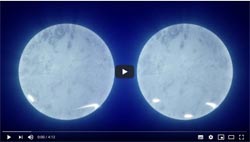
NASA Mission Delivers Best-ever Pulsar Measurements – Research Group of TU Darmstadt involved

Video on YouTube
The pulsar in question, J0030+0451 (J0030 for short), lies in an isolated region of space 1,100 light-years away in the constellation Pisces. While measuring the pulsar's heft and proportions, NICER revealed that the shapes and locations of million-degree “hot spots” on the pulsar’s surface are much stranger than generally thought.
“From its perch on the space station, NICER is revolutionizing our understanding of pulsars,” said Paul Hertz, astrophysics division director at NASA Headquarters in Washington.
“Pulsars were discovered more than 50 years ago as beacons of stars that have collapsed into dense cores, behaving unlike anything we see on Earth. With NICER we can probe the nature of these dense remnants in ways that seemed impossible until now.”
Scientists from the TU Darmstadt have provided the expertise for understanding the impact of the NICER observations for the equation of state of dense matter. A series of papers analyzing NICER’s observations of J0030 appears in a focus issue of The Astrophysical Journal Letters and is now available online: https://bit.ly/2siStnO.
How do pulsars work?
When a massive star dies, it runs out of fuel, collapses under its own weight and explodes as a supernova. These stellar deaths can leave behind neutron stars, which pack more mass than our Sun into a sphere roughly as wide as the greater area of Darmstadt.
Pulsars, which are one class of neutron star, spin up to hundreds of times each second and sweep beams of energy toward us with every rotation. J0030 revolves 205 times per second.
For decades, scientists have been trying to figure out exactly how pulsars work. In the simplest model, a pulsar has a powerful magnetic field shaped much like a household bar magnet. The field is so strong it rips particles from the pulsar’s surface and accelerates them.
Some particles follow the magnetic field and strike the opposite side, heating the surface and creating hot spots at the magnetic poles. The whole pulsar glows faintly in X-rays, but the hot spots are brighter. As the object spins, these spots sweep in and out of view like the beams of a lighthouse, producing extremely regular variations in the object’s X-ray brightness. NICER measures the arrival of each X-ray from a pulsar to better than a hundred nanoseconds, a precision about 20 times greater than previously available, so scientists can take advantage of this effect for the first time.
Different modelling approaches
Using NICER observations from July 2017 to December 2018, two groups of scientists mapped J0030’s hot spots using independent methods and converged on similar results for its mass and size. A team led by the University of Amsterdam, determined the pulsar is around 1.3 times the Sun’s mass and 15.8 miles (25.4 kilometers) across. A second team found J0030 is about 1.4 times the Sun’s mass and slightly larger, about 16.2 miles (26 kilometers) wide.
“It’s remarkable, and also very reassuring, that the two teams achieved such similar sizes, masses and hot spot patterns for J0030 using different modeling approaches,” said Zaven Arzoumanian, NICER science lead at NASA’s Goddard Space Flight Center in Greenbelt, Maryland. “It tells us NICER is on the right path to help us answer an enduring question in astrophysics: What form does matter take in the ultra-dense cores of neutron stars?”
Together with the NICER collaboration Svenja Greif, Kai Hebeler, and Achim Schwenk from TU Darmstadt investigated the implications of these new measurements for the properties of dense matter. “It is exciting to see that the new NICER results are consistent with our understanding of strong interactions in atomic nuclei,” said Svenja Greif, whose recent doctoral dissertation within the DFG (Deutsche Forschungsgemeinschaft) funded Collaborative Research Center 1245 on nuclear structure physics and nuclear astrophysics laid the ground-work for the modelling of dense matter in neutron star interiors. In the future, more precise measurements from the NICER mission in combination with improved microscopic calculations thus promises to significantly improve our understanding of the densest matter in the Universe.
Additional Information:
NASA news story: https://www.nasa.gov/feature/goddard/2019/nasa-s-nicer-delivers-best-ever-pulsar…
Video on YouTube: https://youtu.be/zukBXehGHas
Additional resources: https://svs.gsfc.nasa.gov/13240
PR 86/2019: TU Darmstadt /Adapted, original text by Jeanette Kazmierczak, NASA’s Goddard Space Flight Center, Greenbelt, Md.
About TU Darmstadt
The Technische Universität (TU) Darmstadt is one of Germany’s leading technical universities. TU Darmstadt incorporates diverse science cultures to create its characteristic profile. The focus is set on engineering and natural sciences, which cooperate closely with outstanding humanities and social sciences. We are enjoying a worldwide reputation for excellent research in our highly-relevant, focused profile areas: cybersecurity, internet and digitalisation, nuclear physics, fluid dynamics and heat- and mass transfer, energy systems and new materials for product innovation. We dynamically develop our portfolio of research and teaching, innovation and transfer, in order to continue opening up important opportunities for the future of society. Our 308 professors, 4,500 scientific and administrative employees and about to 25,200 students devote their talents and best efforts to this goal. Together with Goethe University Frankfurt and Johannes Gutenberg University Mainz, TU Darmstadt has formed the strategic Rhine-Main Universities alliance.












